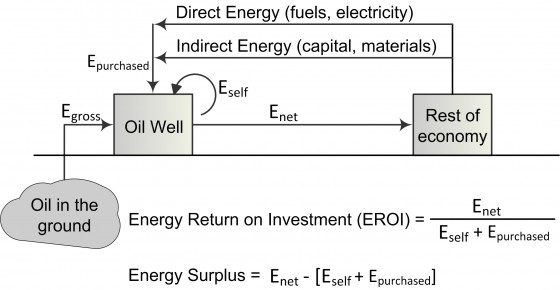EROI (see Figure 1) stands for Energy Return on Energy Input/Invested. As availability of easily accessible fuels decreases, the concept of EROI becomes more relevant. Essentially, it asks – how much energy does one need to invest to get a certain amount of energy back? For example, when extracting oil, when you first strike a well the crude may come gushing out like a geyser, as the oil level goes down, one needs to invest increasing amounts of energy to pump the oil out of the ground, refine the oil and so on. In fact, it may reach a point where more energy would be needed to be invested in pumping, refining and so on, that it makes more sense to leave the rest of the oil in the ground. This is the point when the EROI is below 1. If one energy unit is needed to get three or four (as it occurs in the best of cases with biofuels), then the amount of energy available for other sectors of the economy is too little to maintain a high standard of living.
EROI is an analytic tool for the evaluation of energy systems that seeks to compare the amount of energy delivered to society by a technology to the total energy required to find, extract, process, deliver and otherwise upgrade that energy to a socially useful form. The acronym was introduced by Charles Hall. EROI is expressed as the ratio of energy delivered to energy costs. For instance, energy from the Alberta tar sands in Canada or energy from so-called biofuels is very expensive to produce in terms of energy, as the energy surplus obtained is relatively small. To calculate the energy cost of energy, or any good or service, one must be able to quantify in energy terms the fuel, capital, materials and labour used in the extraction and processing of the energy in question.
EROI calculations are market-determined to the degree that they depend on the technology, industry structure, discount rate and prices that exist at the time. Changes in any of those factors will alter the energy costs of goods, and thereby alter the results of net energy analysis (Cleveland, 2008). Net energy analysis seeks to assess the direct and indirect energy required to produce a unit of energy. Direct energy is the fuel or electricity used directly in the extraction or generation of a unit of energy. An example is the natural gas burned in engines that pump oil to the surface. Indirect energy is the energy used elsewhere in the economy to produce the goods and services used to extract or generate energy. An example of this is the energy used to manufacture the drilling rig used to find oil. The direct and indirect energy use is called ‘embodied’ energy (Cleveland, 2008) although in reality it is energy that has been spent, dissipated.
Many economists view net energy analysis as yet another physical model of scarcity which, like the classical economic scarcity model and The Limits to Growth physical models, they see as inferior to the neoclassical view of scarcity. Some energy analysts, such as Odum, Hannon and Costanza, proposed in the early 1970s a theory of economic and social value based on energy, which economists were quick to criticise (Cleveland, 2008).
Nowadays, ecological economists argue that net energy analysis does not provide a theory of value, but it has several advantages over standard economic analysis: (1) It assesses the change in the physical scarcity of energy resources, it shows the increasing energy costs of obtaining energy; (2) because goods and services are produced from the conversion of energy into useful work, net energy is a measure of the potential to do useful work in economic systems; and (3) EROI can be used to rank alternative energy supply technologies according to their potential abilities to do useful work in the economy.
To Cleveland (2008), the economic significance of the EROI ‘does not hinge on the existence or nonexistence of a causal link between changes in the EROI and changes in the structure and direction of change in the economy’ in the sense of some form of ‘energetic determinism’. Social and cultural factors too merit consideration. Nevertheless, the fact is that economic growth will be slowed down as we enter a period of decreasing EROI, that is, of increasing energy costs of obtaining energy. For instance, getting oil as we go down the Hubbert curve (after peak oil) will very likely require increasing amounts of energy as the oil is to be found in remote places or at great depth under the sea.
References
Cleveland, C. (Lead Author), Costanza, R. (Topic Editor). (2008) Net energy analysis. in: Encyclopedia of Earth. Eds. Cutler J. Cleveland [Online] URL: http://www.eoearth.org/article/Net_energy_analysis [First published in the Encyclopedia of Earth September 14, 2006; Last revised July 23, 2010; Last viewed November 11, 2012.
For further reading:
Hall, C.A.S., Cleveland, C.J., Kaufmann, R.K. (Eds.) (1986) Energy and Resource Quality, The Ecology of the Economic Process. Wiley-Interscience, New York.
This glossary entry is based on contributions by Willi Haas, Simron Jit Singh and Annabella Musel
EJOLT glossary editors: Hali Healy, Sylvia Lorek and Beatriz Rodríguez-Labajos




